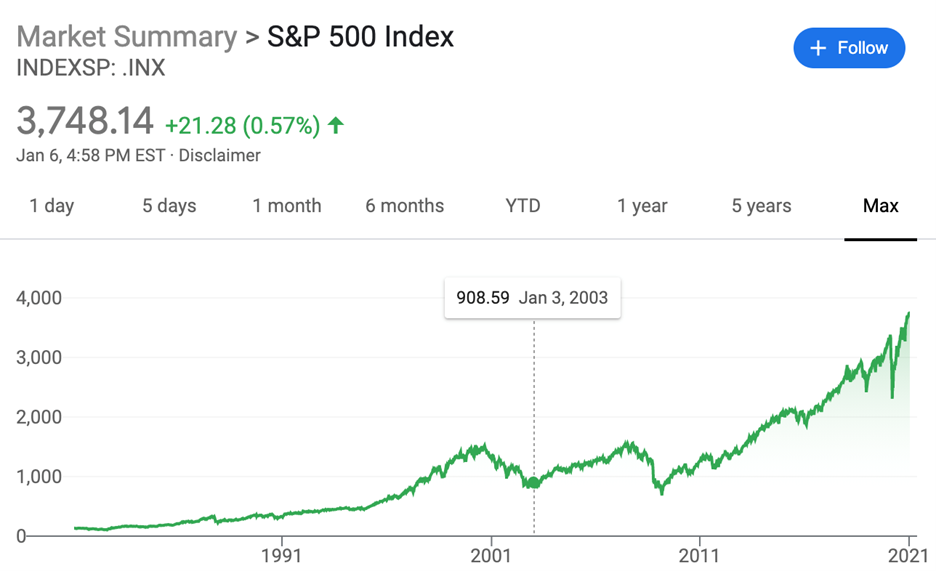Foolproof FIT Finance #2: Savings Accounts Are Not Enough

In the last installment of "Foolproof FIT Finance," we covered how to make it as easy as possible to save money. Now, we need to talk about what to do with that extra money once you have saved up to three to six months' worth of expenses. The three to six months of expenses should be held in a savings account as an emergency fund. Any money saved above this amount can be used to work for you.
If you have not put your money in a high-yield savings account, you should. Most banks give you terrible interest rates, so it benefits you to shop around. My starter bank account gave me less than 0.001% per year. A high-yield, online account will give you about 0.6% per year. It does not seem like much but that is still a 600-fold difference!
Savings accounts are a great place to keep your emergency fund. However, savings accounts are not great places to keep all of your money. Over the long run (and we are in this for the long-run), even high-yield savings accounts lose money.
Savings accounts lose money because they do not account for inflation. Inflation is the decline in purchasing power of money over time. As purchasing power drops, you need more and more money to buy the same amount of a good. Inflation is why your grandparents say everything costs more these days. Over the years, the price of goods slowly increases. Gas ($0.31 per gallon), Coca-Cola ($0.05 per 6 ounces) and ground beef ($0.29 per pound) are all more expensive today than they were in 1960, partially because of inflation. The dollar just is not worth as much as it was sixty years ago.
The Federal Reserve targets an inflation rate between 2-3% annually. With an increase in cost of everything-you-buy of 2 – 3% per year, and a measly savings account interest rate of 0.6%, your money buys less and less each year. We hardly notice this because the percentage is so small, but these small percentages build up slowly to cause devastating effects, like an atheroma that silently grows until it ruptures.
To counteract inflation, smart people like you put money into vehicles with an interest rate that is higher than the inflation rate. The highest yield savings account is not making you more than 2 – 3% per year, but there are other ways to ensure your money keeps up with inflation: investing.
Investing in the stock market is a great way to build more wealth because it allows your money to grow while you are busy in clinic, seeing another consult or running in to the hospital at 2 a.m. for a STEMI.
One of my co-fellows got really into the stock market this past March when it crashed. He spent a lot of time reading which stocks to get. He checked the market multiple times each day. He gained money and he lost money. He has spent about nine months in the stock market as a cardiology fellow and now he is already burnt out because he had to spend so much time reading and paying attention to the market.
Here is the problem: professionals spend a lot of time, energy, and money trying to stay ahead of the stock market, and they still get it wrong and often do not beat the market. It consumes their lives. Despite all of the resources they put in, sometimes they make money. I would expect better results for professionals.
As a fellow, you do not have time or energy to worry about the latest news regarding your hot stock pick. Fellowship requires a much more reliable and hands-off approach – the "Set It and Forget It Method" of Investing also known as Index funds.
If you like spending lots of time and energy worrying about your money, then stop reading. This is for the fellows that want to spend less time worrying and more time on the important things in life, like improving diversity in cardiology or spending your few minutes outside the hospital with loved ones.
Index funds are my favorite way to invest money. An Index fund by definition is a portfolio of stocks or bonds designed to mimic a financial market index. This is a passive strategy that has low risk. This is a fund (a group of stocks), not a single stock. This means your gains will follow the market you invested. Investing in a S&P 500 index fund means you are investing in all of the S&P 500 companies, which is highly likely to increase in value (Figure 1).
Instead of trying to pick which individual stock will perform the best, you get to buy a bunch of stocks, which will include the best performing stocks. Do not waste time and money searching for the needle in a haystack when you can buy the whole haystack. You will miss the highs of betting on a winning company, but you also will not be pulling your hair out when a company's stock hits rock bottom.
The advantage to these funds is not that you will be making the most amount of money, but that you do not have to worry so much about your investments. You gain all of that time and energy back and you can spend it worry free, however you want.
There are a few nuts and bolts to pay attention to, but this short list should get you started on good index funds to look into:
- FNILX – Fidelity SP500 Index Fund
- FZROX – Fidelity Total Stock Market Fund
- FZILX – Fidelity International Stock Market Fund
- FXIAX – Fidelity Fund Total Stock Market Fund
- SWTSX – Charles Schwab Fund
- SWPPX – Charles Schwab SP500 Fund
- VTSAX – Vanguard Fund Total Stock Market
- VFIAX – Vanguard Fund SP500 Fund
Investing allows your money to grow and keep up with inflation, but it would take more than a second full-time job to constantly stay ahead of and profit from the stock market. Index funds provide a low-cost, no hassle way to take advantage of the growing American markets and still get restful sleep at night (at least when you are not on call).
Read more here:


